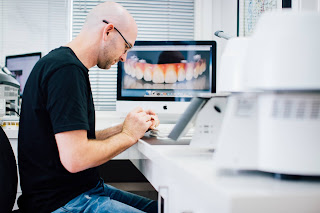How Many Dental Implants and Stages is Best
When a full set teeth replacement is required, certain dentists and specialists may often recommend six or more dental implants to support the prosthesis, and would undertake the treatment in multiple stages. All-On-4 is different in that only four fixtures are used to support the teeth, and the treatment is immediate with the final prosthesis being typically delivered within 24 hours of the surgery. So not only less implants are being used, but also these are immediately loaded, and the natural question arises are we pushing the limits? Would it be better to use more implants and to do it in stages?
Actually, the answer is quite the opposite. Staged, multi-implant systems have been around for many years, but the trend among experienced clinicians has been to use less implants and to undertake immediate loading with the ultimate aim of achieving a better outcome. So All-On-4 is actually a product of evolution (see History of All-On-4).
Nonetheless, All-On-4 is an advanced surgical and restorative oral rehabilitation system. It requires not only advanced skills and a great deal of experience, but also integrated dental, surgical and laboratory facilities. As such, not all dentists or specialists are, in fact, able to offer this treatment.
The Ideal Number of dental implants kew
The problem with full set implants is that the more implants we put in the more difficult it is for patients to clean around them because the implants are not actually visible. If you cannot clean them, then they will be smelly and will not last long.
More implants is also less comfortable for patients because of the increased number of screw access holes, which is additionally a known technical obstacle to achieving the best possible aesthetic result.
Four implants is ideal because there are two in the front and two in the back, and because of the way they are tilted not only do they provide the necessary support, but the spread also makes it more comfortable, more aesthetic, and much easier to know how to clean.
All-On-4 Immediate dental Implants
There are situations where we might consider placing one or more additional implants. This is very rarely the case in the lower jaw, but may be necessary in a small percentage of upper jaws depending on individual bone situations, biting pressures, and other parameters that we must take into account in our planning. Though in doing so we must always remain focused on our quality standards to ensure simple cleaning, optimal function, ultimate aesthetics and longevity. In some instances we may still be able to revert to using only four supports with a special kind of implants know as Zygomas, even when the jaw bone quality is extremely poor, because these actually rely on the cheekbones for support.
The Ideal Number of Stages
Traditionally, implants were done over a number of stages where after surgery the patients were committed either to a denture or an unreliable temporary restoration until the permanent teeth can be fitted. Over the years numerous studies have shown that apart from being poorly fitting and uncomfortable for patients, these may actually cause inadvertent issues with the healing of the implants because of individual concentrated pressures from movement of the dentures or temporary restorations.
Immediate loading is a concept that emerged in the late 90’s to avoid or reduce the undesirable impact of a temporary restoration on the healing of the implants. In full arch rehabilitation, when the teeth are immediately and reliably connected to the implants, the biting pressures are shared and distributed between all the implants, which reduces the impact on individual implants and allows them to more freely and more reliably be integrated within the host bone. When immediate loading is undertaken, we often require our patients to be on a soft diet for 4 months, eating foods the consistency of fish, pasta, soft chicken, and avoiding things like nuts, apples, bones, bread crusts, and steak.
At all on 4 perth Clinic our immediate teeth replacement system enables us to complete total rehabilitation within 24 hours of surgery with teeth that are final and which do not require subsequent replacement. The teeth are made from a uniquely designed metal-reinforced high-impact acrylic. Although permanent, these teeth will wear over time, and may need to be replaced at some stage. The longevity varies from patient to patient depending on the strength of their bite, the types of food they eat, or if they grind their teeth. We indicate an average longevity of 5 years because even though in many of our patients these teeth last for 10 years and longer, we also have cases where they last less than 5 years.
When its time to replace the All-On-4 implant teeth, the process is quite simple, non-costly and does not require any additional surgery or anaesthetic. At that time, the patient may elect to have the exact same kind of teeth, and thus expect similar longevity once again, or they might instead consider changing the teeth to a Zirconia material to improve durability and increase the expected longevity. The Zirconia is not going to look better than the original teeth, as we put a lot of effort to get it right in the first place, but they are just going to last much longer. As such it is unnecessary to upgrade to Zirconia before it is time to do so due to the wear and tear of the original teeth. Unfortunately it is not possible or desirable to fit the Zirconia teeth as an immediate restoration because of its weight and rigidity, which could have an impact on the integration of the implants during the initial four months of healing.

Comments
Post a Comment